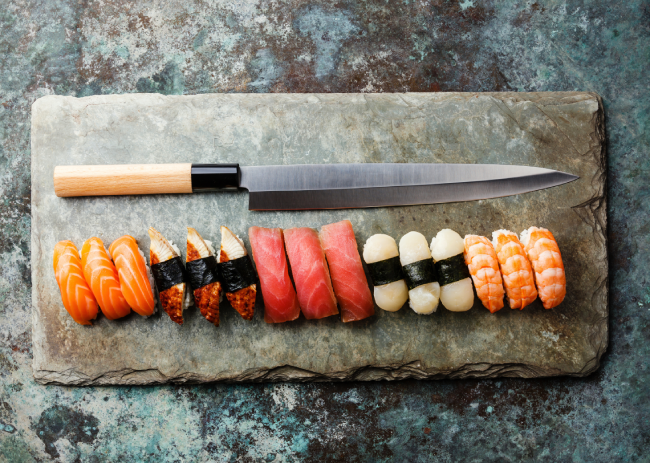Japanese knives are known around the world for their precision, beauty, and craftsmanship. If you love cooking or are just starting to explore Japanese cutlery, understanding the Japanese knife anatomy is important. Knowing the parts of a knife helps you use it better, care for it properly, and sharpen it with confidence.
In this guide, we will break down the key features of Japanese knives. From the strong spine to the sharp tip, each part plays an important role in how the knife performs.
The Basics of Japanese Knife Anatomy
Japanese knives differ from Western knives in several important ways. They are often lighter and thinner, with sharper edges that make them ideal for delicate cutting and precise slicing.
A knife generally consists of three main parts: the blade, the handle, and the tang that connects them. Within the blade itself, there are several important sections that give the knife its unique abilities. These include the spine, heel, edge, and tip. Each plays a specific role in how the knife performs during use.
The Spine: The Backbone of the Knife
The spine is the thick, unsharpened edge running along the top of the blade, often called the back of the knife. This part adds strength and helps balance the knife. The thickness of the spine varies depending on the knife’s purpose.
For instance, heavier knives like the Deba have a thick spine to provide extra power for chopping, while knives like the delicate Yanagiba feature a thinner spine to allow for precise, controlled slicing. When holding a knife, the spine helps balance the overall weight. A well-balanced knife feels comfortable and steady in your hand, giving you better control during cutting.
The Heel: Where Power Begins
The heel is the rear part of the blade, closest to the handle. It is usually the thickest and strongest part of the cutting edge. The heel is great for heavy-duty tasks like chopping bones or cutting tough vegetables.
In Japanese knives such as the Gyuto, the heel provides strength without adding too much weight. Some knives have a broader heel, making them suitable for pushing down hard during cutting. Using the heel helps keep your cuts steady and controlled, especially when working with dense ingredients.
The Edge: The Cutting Heart
The edge is the sharpened part of the blade that does the cutting and is the most important part of any knife. Japanese knives have different edge types. Single bevel knives have one sharp side, like the Yanagiba, which allows for precise and clean cuts, especially when slicing raw fish.
Double bevel knives, such as the Santoku, are sharpened on both sides and work well for everyday kitchen tasks. The edge’s angle and sharpness affect how easily the knife cuts. Japanese knives usually have sharper angles than Western knives, making them cut cleaner but also more delicate.
The Tip: Precision and Versatility
The tip is the front point of the blade, used for delicate and detailed cutting tasks. Japanese knives have different tip shapes. Some have sharp, pointed tips for piercing, while others have rounded or flat tips suited for chopping or scooping.
For example, the Kiritsuke features a sharp tip ideal for fine slicing and cutting fish. A well-designed tip makes tasks like trimming herbs, peeling fruits, or making precise cuts easier.
The Blade Face and Bevel
The blade face is the flat or slightly curved surface of the blade. The bevel is the angled area where the blade is sharpened to form the cutting edge. Bevel shapes and angles vary by knife type. Santoku knives, known for versatility, usually have a wider bevel angle for durability and ease of use.
Nakiri knives, designed for vegetables, have straighter edges and thinner bevels for clean chopping. The bevel’s shape impacts cutting performance and smoothness, which is important to understand when sharpening knives with whetstones.
The Bolster and Handle Connection
A bolster is a thick section of metal between the blade and the handle. Many Western knives have bolsters for added balance and finger protection. Traditional Japanese knives often have a simpler design without a full bolster, making the blade lighter and easier to control.
Japanese knife handles are usually made from wood, with a round or octagonal shape. This gives the cook a comfortable grip for precise control. The handle is attached to the blade by a tang, which can be either full or partial. Ergonomics play an important role in how comfortable the knife feels during long cooking sessions. A well-designed handle reduces hand fatigue and improves safety.
The Tang: The Hidden Strength
The tang is the part of the blade that extends into the handle. It acts as the knife’s hidden backbone and gives it strength and balance.
Japanese knives feature various tang constructions. A full tang extends the entire length of the handle, providing enhanced durability and stability. In contrast, partial tangs, which are more commonly found in traditional Japanese knives, contribute to a lighter overall weight and greater ease of handling.
Popular Japanese Knife Types and Their Anatomy Highlights
Japanese knives come in many shapes and sizes, each designed for specific tasks. Here are a few common types with notable anatomy features:
- Gyuto (Chef’s Knife): A versatile double bevel knife with a balanced spine and heel for all-around kitchen work.
- Santoku (Multipurpose Knife): Known for a slightly wider blade face and a rounded tip, great for slicing, dicing, and chopping.
- Nakiri (Vegetable Knife): Has a flat blade and thin bevel to make clean vegetable cuts.
- Deba (Butchery Knife): Features a thick spine and strong heel for cutting through bones and fish.
- Yanagiba (Slicing Knife): A single bevel knife with a long, thin blade and sharp tip, perfect for slicing raw fish.
The Art and Purpose Behind Japanese Knife Anatomy
Japanese knives are more than just kitchen tools. They are the result of centuries of tradition and skill. From the strong spine to the delicate tip, every part has a purpose. By learning about knife anatomy, you gain respect for these blades and improve your ability to use and care for them.
Take a moment to look at your knives closely. See if you can identify the spine, heel, edge, and tip. With time, you will sharpen your skills and connect deeper with the art of Japanese cutlery.

